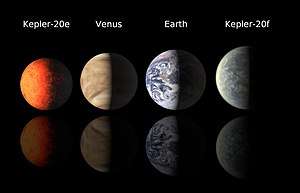Kepler-20
Kepler-20 is a star 929 light-years from Earth in the constellation Lyra with a system of six known planets.[5] The apparent magnitude of this star is 12.51, so it cannot be seen with the unaided eye. Viewing it requires a telescope with an aperture of 15 cm (6 in) or more.[6] It is slightly smaller than the Sun, with 94% of the Sun's radius and about 91% of the Sun's mass. The effective temperature of the photosphere is slightly cooler than that of the Sun at 5466 K, giving it the characteristic yellow hue of a stellar class G8 star.[7][8] The abundance of elements other than hydrogen or helium, what astronomers term the metallicity, is approximately the same as in the Sun. It may be older than the Sun, although the margin of error here is relatively large.[4]
| Observation data Epoch J2000 Equinox J2000 | |
|---|---|
| Constellation | Lyra |
| Right ascension | 19h 10m 47.5235s[1] |
| Declination | +42° 20′ 19.299″[1] |
| Apparent magnitude (V) | 12.51[2] |
| Characteristics | |
| Spectral type | G8[3] |
| Astrometry | |
| Proper motion (μ) | RA: −3.976±0.039[1] mas/yr Dec.: −26.959±0.043[1] mas/yr |
| Parallax (π) | 3.5103 ± 0.0219[1] mas |
| Distance | 929 ± 6 ly (285 ± 2 pc) |
| Details | |
| Mass | 0.912±0.035[4] M☉ |
| Radius | 0.944+0.06 −0.095[4] R☉ |
| Temperature | 5466±93[4] K |
| Metallicity [Fe/H] | 0.02±0.04[4] dex |
| Age | 8.8+4.7 −2.7[4] Gyr |
| Other designations | |
| Database references | |
| SIMBAD | data |
| KIC | data |
Planetary system

On December 20, 2011, the Kepler Space Telescope team reported the discovery of a five-planet system containing three small gas giants and the first two Earth-sized extrasolar planets, Kepler-20e (the first known extrasolar planet smaller than Earth orbiting a main-sequence star)[9] and Kepler-20f, orbiting a Sun-like star.[10] Although the planets are Earth-sized, they are not Earth-like in the respect that they are much closer to their star than Earth, and are hence not near the habitable zone,[11] with expected surface temperatures of 760 °C (1,400 °F) and 427 °C (801 °F), respectively. The three other Neptune-sized planets in the system, Kepler-20b, Kepler-20c, and Kepler-20d, all orbit similarly close to the star.[12][13] Kepler-20g is a non-transiting Neptunian world.
The masses of e and f are expected masses. Their masses are uncertain as they are too small to detect via radial velocity with current technology.[14]
All planets are at small near resonances; proceeding outwards, they are 3:2, 4:2, 2:1, 4:1.
| Companion (in order from star) |
Mass | Semimajor axis (AU) |
Orbital period (days) |
Eccentricity | Inclination | Radius |
|---|---|---|---|---|---|---|
| b | 9.7+1.41 −1.44[15] M⊕ |
0.04537 +0.00054 −0.00060 |
3.6961219 | <0.32 | — | 1.91 R⊕ |
| e | 0.39–1.67 M⊕ | 0.0630 | 6.098493 | <0.28 | — | 0.868 R⊕ |
| c | 16.1 M⊕ | 0.0930± 0.0011 | 10.854092 | <0.40 | — | 3.07 R⊕ |
| f | 0.66–3.04 M⊕ | 0.1370 | 19.57706 | <0.32 | — | 1.034 R⊕ |
| g | 19.96+3.08 −3.61[15] M⊕ |
0.2055 | 34.940 | ≤ 0.16 | — | — |
| d | <20.1 M⊕ | 0.3453 +0.0041 −0.0046 |
77.61184 | <0.60 | — | 2.75 R⊕ |
References
- Brown, A. G. A.; et al. (Gaia collaboration) (August 2018). "Gaia Data Release 2: Summary of the contents and survey properties". Astronomy & Astrophysics. 616. A1. arXiv:1804.09365. Bibcode:2018A&A...616A...1G. doi:10.1051/0004-6361/201833051. Gaia DR2 record for this source at VizieR.
- Lasker, Barry M.; et al. (August 2008), "The Second-Generation Guide Star Catalog: Description and Properties", The Astronomical Journal, 136 (2): 735–766, arXiv:0807.2522, Bibcode:2008AJ....136..735L, doi:10.1088/0004-6256/136/2/735
- "Kepler-20 -- Star", SIMBAD, Centre de Données astronomiques de Strasbourg
- Schneider, Jean, "Star : Kepler-20", The Extrasolar Planets Encyclopaedia, CNRS/LUTH - Paris Observatory, archived from the original on 2012-01-19, retrieved 2011-12-21
- Johnson, Michele (20 December 2011). "NASA Discovers First Earth-size Planets Beyond Our Solar System". NASA. Retrieved 20 December 2011.
- Sherrod, P. Clay; Koed, Thomas L. (2003), A Complete Manual of Amateur Astronomy: Tools and Techniques for Astronomical Observations, Astronomy Series, Courier Dover Publications, p. 9, ISBN 0-486-42820-6
- "The Colour of Stars", Australia Telescope, Outreach and Education, Commonwealth Scientific and Industrial Research Organisation, December 21, 2004, archived from the original on 10 March 2012, retrieved 16 January 2012
- Fressin, Francois; et al. (February 2012). "Two Earth-sized planets orbiting Kepler-20". Nature. 482 (7384): 195–198. arXiv:1112.4550. Bibcode:2012Natur.482..195F. doi:10.1038/nature10780. PMID 22186831.
- NASA Staff. "Artist's Concept of Kepler-20e". NASA. Retrieved 19 November 2014.
- http://kepler.nasa.gov/news/nasakeplernews/index.cfm?FuseAction=ShowNews&NewsID=172
- Hand, Eric (20 December 2011). "Kepler discovers first Earth-sized exoplanets". Nature. doi:10.1038/nature.2011.9688.
- Overbye, Dennis (20 December 2011). "Two Earth-Size Planets Are Discovered". New York Times. Retrieved 2011-12-21.
- Tate, Karl (20 December 2011). "At Last, Earth-Sized Alien Worlds (Infographic)". Space.com. Retrieved 2011-12-21.
- Fressin, Francois; et al. (20 December 2011). "Two Earth-sized planets orbiting Kepler-20". Nature. 482 (7384): 195–198. arXiv:1112.4550. Bibcode:2012Natur.482..195F. doi:10.1038/nature10780. PMID 22186831.
- Buchhave, Lars A.; et al. (14 November 2016). "A 1.9 Earth radius rocky planet and the discovery of a non-transiting planet in the Kepler-20 system". The Astronomical Journal. 152 (6): 160. arXiv:1608.06836. Bibcode:2016AJ....152..160B. doi:10.3847/0004-6256/152/6/160.
External links
| Wikimedia Commons has media related to Kepler-20. |
- Multimedia:
- Video (01:33) NASA Discovers First Earth-like Exoplanet Orbiting A Sun-like Star.


.jpg)